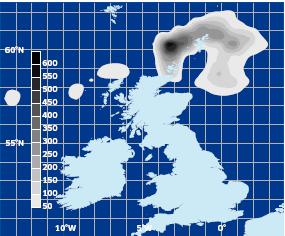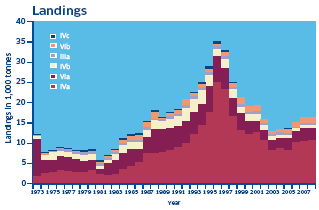Introduction
Until the mid 1980s this species was taken mainly as a by-catch in bottom trawl fisheries. Monkfish is caught all year round, mainly as part of a mixed fishery but also as the target of a more specialised fishery off the Scottish west coast. The fishery in the North Sea is closely associated with the fishery to the west of Scotland and it is likely that catches from the two areas come from the same biological stock. Both the Scottish and the total international landings of monkfish from the North Sea and west of Scotland have rapidly declined from their peak in 1996.
Biology

There are two species of anglerfish, also called monkfish, in Scottish waters. The black-bellied monkfish, Lophius budegassa, is much less common than the ‘white’ monkfish, Lophius piscatorius. The basic biology of the two species is very similar. Monkfish occur in an unusually wide range of depths, extending from very shallow inshore waters down to at least 1,100m. Small monkfish can be caught over most of the northern North Sea and west coast grounds, down to about 150m. large fish, the potential spawners, used to be found at all depths, including inshore waters, but are now scarce in water shallower than 100-150 m.
Spawning takes place mainly during the first six months of the year and is believed to occur in relatively deep water. Although monkfish have a long spawning season, each female probably produces only one batch of eggs, unlike cod, haddock and whiting, which spawn many times during a single spawning season. female monkfish only begin to reach maturity around the age of seven years when they have grown to a length of about 70cm. The majority of females do not spawn until they are even older and are therefore likely to be caught long before they reach full maturity. Monkfish have very unusual spawning habits. The eggs are released in a huge ribbon of jelly that floats to the surface and drifts with the currents. A single egg ribbon can be more than 10 metres long and can contain well over 1 million eggs. After hatching, the young monkfish spend three or four months in mid-water, before settling on the bottom at a size of 5-12cm. during their time in mid-water the young fish may drift a very long way from the spawning grounds.
Monkfish feed mainly on fish, although shellfish and even seabirds are sometimes found in their stomachs. They lie on the seabed and attract prey to within range of their enormous mouths by twitching a ‘fishing rod’, or lure, that extends from the top of the head, in front of the eyes.

ICES Advice on Management

Summary
- The state of the stock is unknown
- Industry/science anglerfish surveys into their fifth year
- ICES advises no increase in fishing effort
Precautionary approach reference points
The reference points defined in 1998 were intrinsically linked to the analytical assessment at the time. New reference points will be defined when a new assessment procedure is developed.
State of stock
The state of the stock is unknown. There are major uncertainties about catch and effort data for anglerfish as well as limited knowledge about population dynamics. Surveys carried out with industry co-operation indicate that the abundance has declined in recent years in most areas: biomass increased up until 2008, but has since decreased.
Management advice
There are no explicit management objectives for this stock; the European Community and Norway are currently discussing the joint management of this shared stock.
It has been noticed by ICES that the current EUagreed TAC for Subarea IV and EC waters of Division IIa as well as the EU-Norway-agreed TAC for the Norwegian North Sea EEZ do not include Division IIIa: in Division IIIa there are apparently no internationally agreed management rules for anglerfish. Recent attempts to identify anglerfish fisheries in
Divisions IV and VI have shown that the majority of the catch of anglerfish stems from mixed trawl fisheries, catching sole, saithe, plaice, megrim, Nephrops, haddock, and cod. While the landings value of anglerfish may constitute a high percentage of the total, the landings in weight tend to be only a relatively low percentage of the total. Optional effort restrictions aiming at promoting a recovery of these other species will have a side-effect for the anglerfish too, although a shift from anglerfish-poor areas to anglerfish-rich areas could negate this effect.
ICES previously advised a two-stage approach for management of the anglerfish fishery. The first stage was to substantially improve the quality and quantity of data collected on the fishery while maintaining exploitation at its current level. This first stage of data collection was expected to take at least five years, establishing useable time-series of fisheries-dependent and -independent data. This stage will be into its fifth year in 2009 and includes:
- Dedicated Scottish and Irish industry/science anglerfish surveys from 2005-2009;
- A Scottish tallybook scheme (linked to a longer time-series of personal diaries) from 2006-2009;
The second stage would then be to use these data to examine alternative management approaches and harvest control rules appropriate to this fishery. ICES considers that the approach should continue, as it is expected to yield useful information in the medium term for the management of this stock.
The results from the surveys were considered by a recent workshop on anglerfish and megrim. It was concluded that the surveys could be used to provide information on changing stock size, for example in relation to European Commission’s position on Managing Fish Stocks without Catch Option Tables. ICES advises on the basis of precautionary considerations that the effort in fisheries that catch anglerfish should not be allowed to increase.
Management action
At the December 2009 meeting in Brussels, the Council of Ministers decided that the eu Total Allowable Catch for the northern shelf (IV and VI, eC waters of IIa and vb, and international waters of xII and xIv) monkfish should be 16,912 tonnes. The uk quota for 2010 was set at 10,936 tonnes, this excludes any quota set for catch in the Norwegian waters of IV.
June 2010
